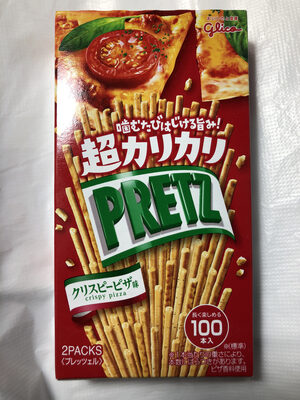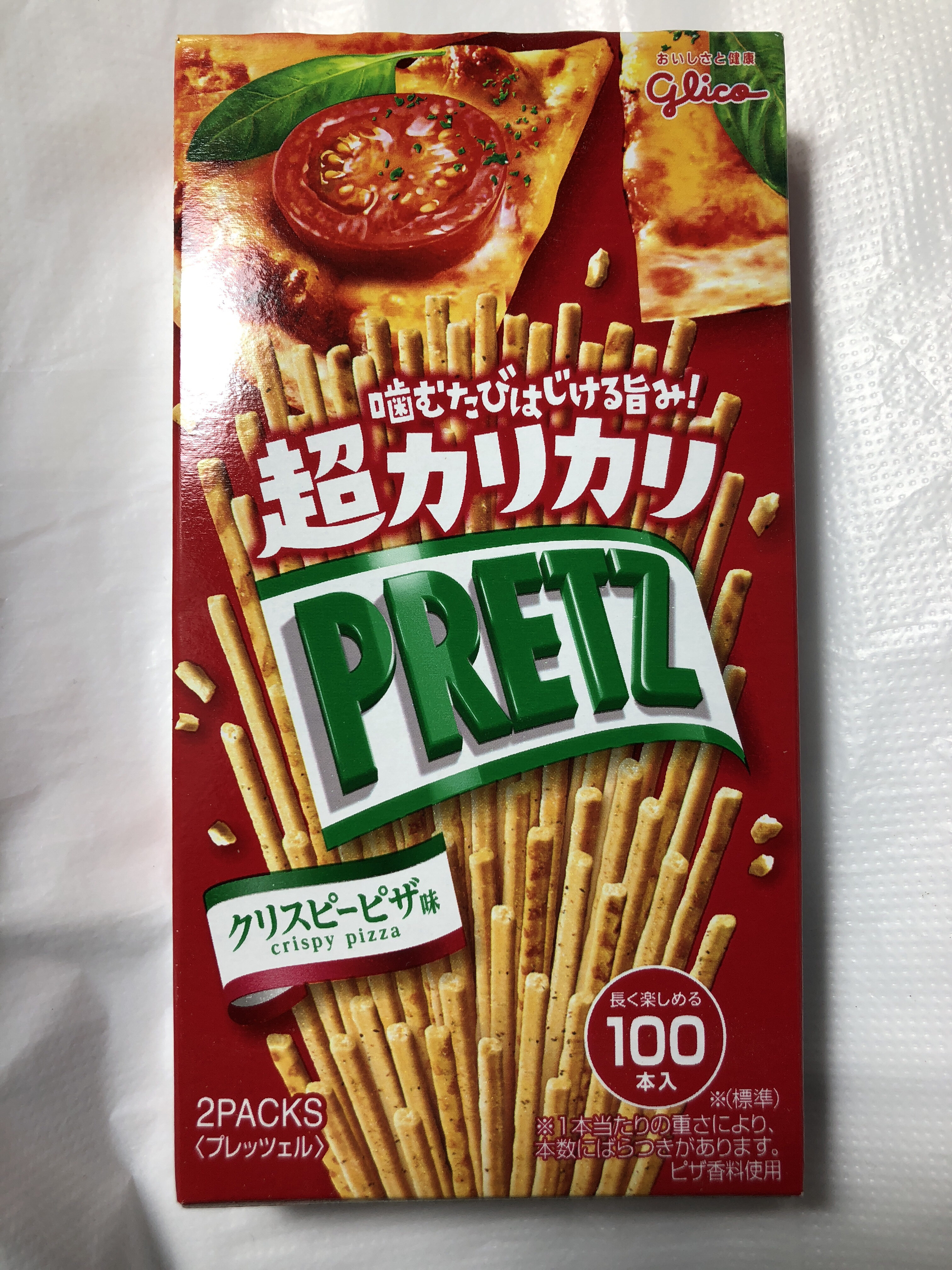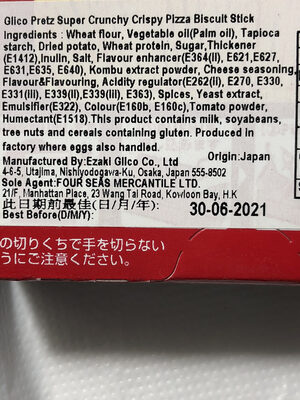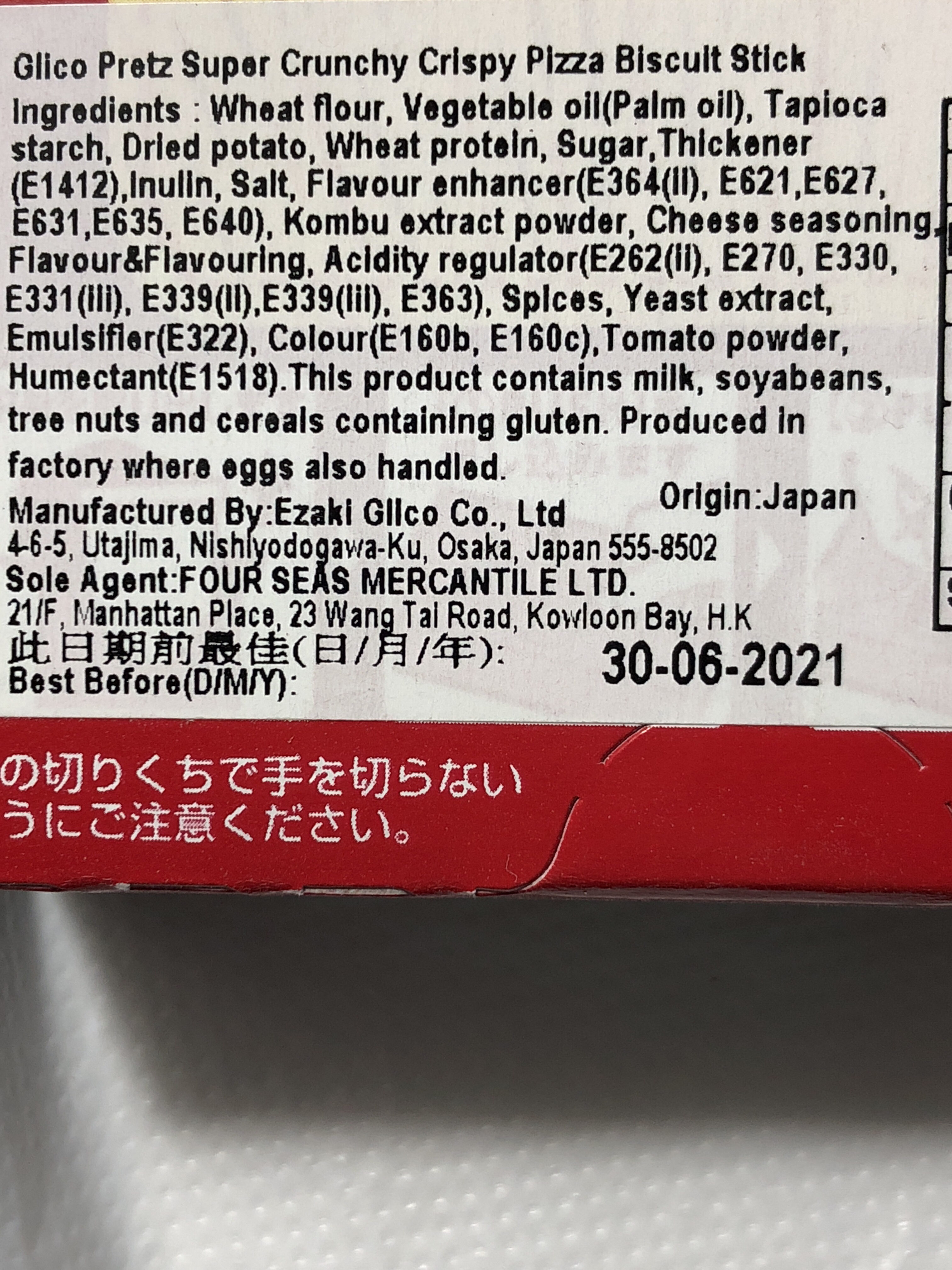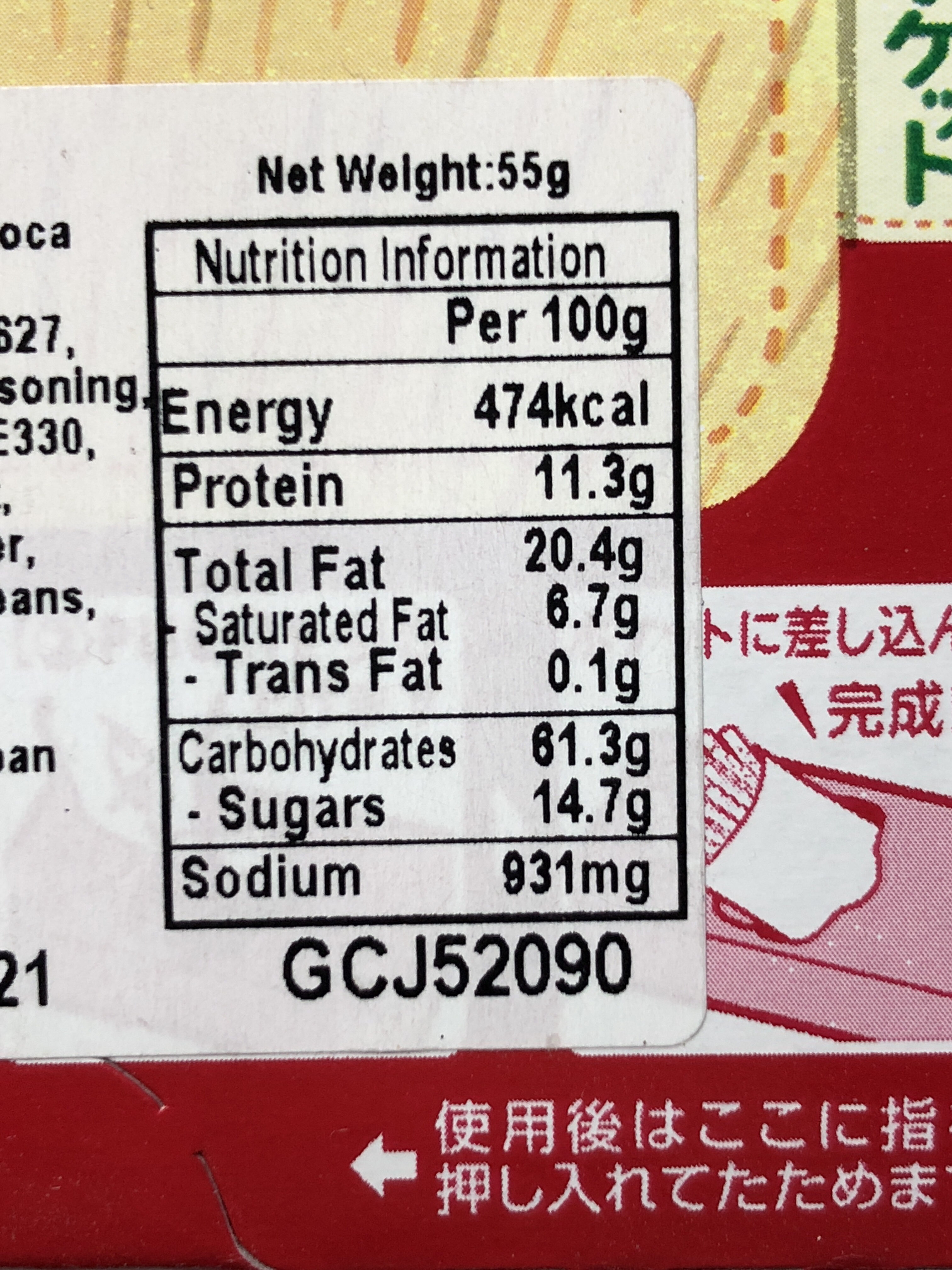食料の透明性を向上させてください!
非営利団体として、私たちは世界中の消費者に自分たちが食べているものについて情報を提供し続けるために、皆様の寄付に頼っています。
食の革命はあなたから始まります!
Pretz クリスピーピザ味 - 55 g
Pretz クリスピーピザ味 - 55 g
この商品ページは完成していません。既存の写真からデータを編集または追加したり、 Android または iPhone/iPad のアプリを使用して写真を撮影して、手伝ってください。ありがとうございます!
×
バーコード: 4901005520905 (EAN / EAN-13)
数量: 55 g
パッケージング: en:Paper box
カテゴリー: en:Snacks, en:Salty snacks, en:Sweet snacks, 前菜, en:Biscuits and cakes, ビスケット
成分の起源: 日本
販売の国: 日本
好みに合わせて
健康
原材料
-
43 個の原材料
: Wheat flour, Vegetable oil(Palm oil), Tapioca starch, Dried potato, Wheat protein, Sugar,Thickener (E1412),Inulin, Salt, Flavour enhancer(E364(II), E621,E627, E631,E635, E640), Kombu extract powder, Cheese seasoning, Flavour&Flavouring, Acidity regulator(E262(II), E270, E330, E331 (III), E339(II),E339(III), E363), Spices, Yeast extract, Emulsifler(E322), Colour(E160b, E160c),Tomato powder, Humectant(E1518). This product contains milk, soyabeans, tree nuts and cereals containing gluten. Produced in factory where eggs also handled. Origin:Japanアレルゲン: 小麦/そば, 乳, くるみ/アーモンド
食品加工
-
超加工食品
製品が en:4 - Ultra processed food and drink products グループに属することを示す要素:
- 添加物: E1412
- 添加物: E160b - アナトー色素
- 添加物: E160c - パプリカ色素
- 添加物: E322
- 添加物: E621 - L-グルタミン酸ナトリウム
- 添加物: E627
- 添加物: E631
- 添加物: E635 - 5'-リボヌクレオチド二ナトリウム
- 添加物: E640
- 原材料: 着色料
- 原材料: Flavour enhancer
- 原材料: Humectant
- 原材料: 増粘剤
食品は加工の程度に応じ、4つのグループに分類されます:
- 未加工または最小加工食品
- 加工された料理の材料
- 加工食品
- 超加工食品
グループの判定は製品のカテゴリと含まれる原材料に基づいています。
添加物
-
E1518
Triacetin: The triglyceride 1‚2,3-triacetoxypropane is more generally known as triacetin and glycerin triacetate. It is the triester of glycerol and acetylating agents, such as acetic acid and acetic anhydride. It is a colorless, viscous and odorless liquid with a high boiling point. Triacetin was first prepared in 1854 by the French chemist Marcellin Berthelot.情報源: Wikipedia (英語)
-
E262 - 酢酸ナトリウム
Sodium acetate: Sodium acetate, CH3COONa, also abbreviated NaOAc, is the sodium salt of acetic acid. This colorless deliquescent salt has a wide range of uses.情報源: Wikipedia (英語)
-
E262ii - 二酢酸ナトリウム
Sodium acetate: Sodium acetate, CH3COONa, also abbreviated NaOAc, is the sodium salt of acetic acid. This colorless deliquescent salt has a wide range of uses.情報源: Wikipedia (英語)
-
E270 - 乳酸
Lactic acid: Lactic acid is an organic compound with the formula CH3CH-OH-COOH. In its solid state, it is white and water-soluble. In its liquid state, it is colorless. It is produced both naturally and synthetically. With a hydroxyl group adjacent to the carboxyl group, lactic acid is classified as an alpha-hydroxy acid -AHA-. In the form of its conjugate base called lactate, it plays a role in several biochemical processes. In solution, it can ionize a proton from the carboxyl group, producing the lactate ion CH3CH-OH-CO−2. Compared to acetic acid, its pKa is 1 unit less, meaning lactic acid deprotonates ten times more easily than acetic acid does. This higher acidity is the consequence of the intramolecular hydrogen bonding between the α-hydroxyl and the carboxylate group. Lactic acid is chiral, consisting of two optical isomers. One is known as L--+--lactic acid or -S--lactic acid and the other, its mirror image, is D--−--lactic acid or -R--lactic acid. A mixture of the two in equal amounts is called DL-lactic acid, or racemic lactic acid. Lactic acid is hygroscopic. DL-lactic acid is miscible with water and with ethanol above its melting point which is around 17 or 18 °C. D-lactic acid and L-lactic acid have a higher melting point. In animals, L-lactate is constantly produced from pyruvate via the enzyme lactate dehydrogenase -LDH- in a process of fermentation during normal metabolism and exercise. It does not increase in concentration until the rate of lactate production exceeds the rate of lactate removal, which is governed by a number of factors, including monocarboxylate transporters, concentration and isoform of LDH, and oxidative capacity of tissues. The concentration of blood lactate is usually 1–2 mM at rest, but can rise to over 20 mM during intense exertion and as high as 25 mM afterward. In addition to other biological roles, L-lactic acid is the primary endogenous agonist of hydroxycarboxylic acid receptor 1 -HCA1-, which is a Gi/o-coupled G protein-coupled receptor -GPCR-.In industry, lactic acid fermentation is performed by lactic acid bacteria, which convert simple carbohydrates such as glucose, sucrose, or galactose to lactic acid. These bacteria can also grow in the mouth; the acid they produce is responsible for the tooth decay known as caries. In medicine, lactate is one of the main components of lactated Ringer's solution and Hartmann's solution. These intravenous fluids consist of sodium and potassium cations along with lactate and chloride anions in solution with distilled water, generally in concentrations isotonic with human blood. It is most commonly used for fluid resuscitation after blood loss due to trauma, surgery, or burns.情報源: Wikipedia (英語)
-
E322
Lecithin: Lecithin -UK: , US: , from the Greek lekithos, "egg yolk"- is a generic term to designate any group of yellow-brownish fatty substances occurring in animal and plant tissues, which are amphiphilic – they attract both water and fatty substances -and so are both hydrophilic and lipophilic-, and are used for smoothing food textures, dissolving powders -emulsifying-, homogenizing liquid mixtures, and repelling sticking materials.Lecithins are mixtures of glycerophospholipids including phosphatidylcholine, phosphatidylethanolamine, phosphatidylinositol, phosphatidylserine, and phosphatidic acid.Lecithin was first isolated in 1845 by the French chemist and pharmacist Theodore Gobley. In 1850, he named the phosphatidylcholine lécithine. Gobley originally isolated lecithin from egg yolk—λέκιθος lekithos is "egg yolk" in Ancient Greek—and established the complete chemical formula of phosphatidylcholine in 1874; in between, he had demonstrated the presence of lecithin in a variety of biological matters, including venous blood, in human lungs, bile, human brain tissue, fish eggs, fish roe, and chicken and sheep brain. Lecithin can easily be extracted chemically using solvents such as hexane, ethanol, acetone, petroleum ether, benzene, etc., or extraction can be done mechanically. It is usually available from sources such as soybeans, eggs, milk, marine sources, rapeseed, cottonseed, and sunflower. It has low solubility in water, but is an excellent emulsifier. In aqueous solution, its phospholipids can form either liposomes, bilayer sheets, micelles, or lamellar structures, depending on hydration and temperature. This results in a type of surfactant that usually is classified as amphipathic. Lecithin is sold as a food additive and dietary supplement. In cooking, it is sometimes used as an emulsifier and to prevent sticking, for example in nonstick cooking spray.情報源: Wikipedia (英語)
-
E330 - クエン酸
Citric acid: Citric acid is a weak organic acid that has the chemical formula C6H8O7. It occurs naturally in citrus fruits. In biochemistry, it is an intermediate in the citric acid cycle, which occurs in the metabolism of all aerobic organisms. More than a million tons of citric acid are manufactured every year. It is used widely as an acidifier, as a flavoring and chelating agent.A citrate is a derivative of citric acid; that is, the salts, esters, and the polyatomic anion found in solution. An example of the former, a salt is trisodium citrate; an ester is triethyl citrate. When part of a salt, the formula of the citrate ion is written as C6H5O3−7 or C3H5O-COO-3−3.情報源: Wikipedia (英語)
-
E331
Sodium citrate: Sodium citrate may refer to any of the sodium salts of citrate -though most commonly the third-: Monosodium citrate Disodium citrate Trisodium citrateThe three forms of the salt are collectively known by the E number E331. Sodium citrates are used as acidity regulators in food and drinks, and also as emulsifiers for oils. They enable cheeses to melt without becoming greasy.情報源: Wikipedia (英語)
-
E331iii - クエン酸三ナトリウム
Sodium citrate: Sodium citrate may refer to any of the sodium salts of citrate -though most commonly the third-: Monosodium citrate Disodium citrate Trisodium citrateThe three forms of the salt are collectively known by the E number E331. Sodium citrates are used as acidity regulators in food and drinks, and also as emulsifiers for oils. They enable cheeses to melt without becoming greasy.情報源: Wikipedia (英語)
-
E339 - リン酸塩
Sodium phosphates: Sodium phosphate is a generic term for a variety of salts of sodium -Na+- and phosphate -PO43−-. Phosphate also forms families or condensed anions including di-, tri-, tetra-, and polyphosphates. Most of these salts are known in both anhydrous -water-free- and hydrated forms. The hydrates are more common than the anhydrous forms.情報源: Wikipedia (英語)
-
E339ii - リン酸水素二ナトリウム
Sodium phosphates: Sodium phosphate is a generic term for a variety of salts of sodium -Na+- and phosphate -PO43−-. Phosphate also forms families or condensed anions including di-, tri-, tetra-, and polyphosphates. Most of these salts are known in both anhydrous -water-free- and hydrated forms. The hydrates are more common than the anhydrous forms.情報源: Wikipedia (英語)
-
E339iii - リン酸三ナトリウム
Sodium phosphates: Sodium phosphate is a generic term for a variety of salts of sodium -Na+- and phosphate -PO43−-. Phosphate also forms families or condensed anions including di-, tri-, tetra-, and polyphosphates. Most of these salts are known in both anhydrous -water-free- and hydrated forms. The hydrates are more common than the anhydrous forms.情報源: Wikipedia (英語)
-
E363
Succinic acid: Succinic acid -- is a dicarboxylic acid with the chemical formula -CH2-2-CO2H-2. The name derives from Latin succinum, meaning amber. In living organisms, succinic acid takes the form of an anion, succinate, which has multiple biological roles as a metabolic intermediate being converted into fumarate by the enzyme succinate dehydrogenase in complex 2 of the electron transport chain which is involved in making ATP, and as a signaling molecule reflecting the cellular metabolic state. Succinate is generated in mitochondria via the tricarboxylic acid cycle -TCA-, an energy-yielding process shared by all organisms. Succinate can exit the mitochondrial matrix and function in the cytoplasm as well as the extracellular space, changing gene expression patterns, modulating epigenetic landscape or demonstrating hormone-like signaling. As such, succinate links cellular metabolism, especially ATP formation, to the regulation of cellular function. Dysregulation of succinate synthesis, and therefore ATP synthesis, happens in some genetic mitochondrial diseases, such as Leigh syndrome, and Melas syndrome, and degradation can lead to pathological conditions, such as malignant transformation, inflammation and tissue injury.情報源: Wikipedia (英語)
-
E621 - L-グルタミン酸ナトリウム
Monosodium glutamate: Monosodium glutamate -MSG, also known as sodium glutamate- is the sodium salt of glutamic acid, one of the most abundant naturally occurring non-essential amino acids. Glutamic acid is found naturally in tomatoes, grapes, cheese, mushrooms and other foods.MSG is used in the food industry as a flavor enhancer with an umami taste that intensifies the meaty, savory flavor of food, as naturally occurring glutamate does in foods such as stews and meat soups. It was first prepared in 1908 by Japanese biochemist Kikunae Ikeda, who was trying to isolate and duplicate the savory taste of kombu, an edible seaweed used as a base for many Japanese soups. MSG as a flavor enhancer balances, blends, and rounds the perception of other tastes.The U.S. Food and Drug Administration has given MSG its generally recognized as safe -GRAS- designation. A popular belief is that large doses of MSG can cause headaches and other feelings of discomfort, known as "Chinese restaurant syndrome," but double-blind tests fail to find evidence of such a reaction. The European Union classifies it as a food additive permitted in certain foods and subject to quantitative limits. MSG has the HS code 29224220 and the E number E621.情報源: Wikipedia (英語)
-
E627
Disodium guanylate: Disodium guanylate, also known as sodium 5'-guanylate and disodium 5'-guanylate, is a natural sodium salt of the flavor enhancing nucleotide guanosine monophosphate -GMP-. Disodium guanylate is a food additive with the E number E627. It is commonly used in conjunction with glutamic acid. As it is a fairly expensive additive, it is not used independently of glutamic acid; if disodium guanylate is present in a list of ingredients but MSG does not appear to be, it is likely that glutamic acid is provided as part of another ingredient such as a processed soy protein complex. It is often added to foods in conjunction with disodium inosinate; the combination is known as disodium 5'-ribonucleotides. Disodium guanylate is produced from dried seaweed and is often added to instant noodles, potato chips and other snacks, savory rice, tinned vegetables, cured meats, and packaged soup.情報源: Wikipedia (英語)
-
E631
Disodium inosinate: Disodium inosinate -E631- is the disodium salt of inosinic acid with the chemical formula C10H11N4Na2O8P. It is used as a food additive and often found in instant noodles, potato chips, and a variety of other snacks. Although it can be obtained from bacterial fermentation of sugars, it is often commercially prepared from animal sources.情報源: Wikipedia (英語)
原材料分析
-
パーム油
パーム油を含む原材料: パーム油
-
ビーガンか不明
認識されていない原材料: en:e364ii, en:cheese-seasoning, en:flavour-flavouring, E339ii, en:emulsifler, en:soyabeans, en:produced-in-factory-where-eggs-also-handled一部の成分が認識できませんでした。
ご協力をお願いします!
あなたは私たちがより多くの成分を認識し、この製品や他の製品の成分のリストをよりよく分析するのを助けることができます:
- この製品ページを編集して、材料リストのスペルミスを修正したり、材料に関連しない他の言語や文の材料を削除したりします。
- 成分、成分処理方法、およびラベルの多言語リストに、新しいエントリ、同義語、または翻訳を追加します。
手助けしたい場合は Slackのディスカッションスペース で#ingredientsチャンネルに参加したり、 wiki上の成分分析について学んだりしてみてください。ありがとうございます!
-
ベジタリアンか不明
認識されていない原材料: en:e364ii, en:cheese-seasoning, en:flavour-flavouring, E339ii, en:emulsifler, en:soyabeans, en:produced-in-factory-where-eggs-also-handled一部の成分が認識できませんでした。
ご協力をお願いします!
あなたは私たちがより多くの成分を認識し、この製品や他の製品の成分のリストをよりよく分析するのを助けることができます:
- この製品ページを編集して、材料リストのスペルミスを修正したり、材料に関連しない他の言語や文の材料を削除したりします。
- 成分、成分処理方法、およびラベルの多言語リストに、新しいエントリ、同義語、または翻訳を追加します。
手助けしたい場合は Slackのディスカッションスペース で#ingredientsチャンネルに参加したり、 wiki上の成分分析について学んだりしてみてください。ありがとうございます!
-
成分分析の詳細
ご協力をお願いします!
一部の成分が認識できませんでした。
ご協力をお願いします!
あなたは私たちがより多くの成分を認識し、この製品や他の製品の成分のリストをよりよく分析するのを助けることができます:
- この製品ページを編集して、材料リストのスペルミスを修正したり、材料に関連しない他の言語や文の材料を削除したりします。
- 成分、成分処理方法、およびラベルの多言語リストに、新しいエントリ、同義語、または翻訳を追加します。
手助けしたい場合は Slackのディスカッションスペース で#ingredientsチャンネルに参加したり、 wiki上の成分分析について学んだりしてみてください。ありがとうございます!
: Wheat flour, Vegetable oil (Palm oil), Tapioca starch, potato, Wheat protein, Sugar, Thickener (e1412), Inulin, Salt, Flavour enhancer (e364II, e621, e627, e631, e635, e640), Kombu, Cheese seasoning, Flavour&Flavouring, Acidity regulator (e262II, e270, e330, e331III, e339II, e339III, e363), Spices, Yeast extract, Emulsifler (e322), Colour (e160b, e160c), Tomato, Humectant (e1518), soyabeans, tree nuts, cereals containing gluten, Produced in factory where eggs also handled- Wheat flour -> en:wheat-flour - vegan: yes - vegetarian: yes - ciqual_proxy_food_code: 9410 - percent_min: 4.16666666666667 - percent_max: 100
- Vegetable oil -> en:vegetable-oil - vegan: yes - vegetarian: yes - from_palm_oil: maybe - percent_min: 0 - percent_max: 50
- Palm oil -> en:palm-oil - vegan: yes - vegetarian: yes - from_palm_oil: yes - ciqual_food_code: 16129 - percent_min: 0 - percent_max: 50
- Tapioca starch -> en:tapioca - vegan: yes - vegetarian: yes - ciqual_proxy_food_code: 9510 - percent_min: 0 - percent_max: 33.3333333333333
- potato -> en:potato - vegan: yes - vegetarian: yes - ciqual_food_code: 4003 - percent_min: 0 - percent_max: 25
- Wheat protein -> en:wheat-protein - vegan: yes - vegetarian: yes - percent_min: 0 - percent_max: 20
- Sugar -> en:sugar - vegan: yes - vegetarian: yes - ciqual_proxy_food_code: 31016 - percent_min: 0 - percent_max: 14.7
- Thickener -> en:thickener - percent_min: 0 - percent_max: 14.2857142857143
- e1412 -> en:e1412 - vegan: yes - vegetarian: yes - percent_min: 0 - percent_max: 14.2857142857143
- Inulin -> en:inulin - vegan: yes - vegetarian: yes - percent_min: 0 - percent_max: 12.5
- Salt -> en:salt - vegan: yes - vegetarian: yes - ciqual_food_code: 11058 - percent_min: 0 - percent_max: 2.3275
- Flavour enhancer -> en:flavour-enhancer - percent_min: 0 - percent_max: 2.3275
- e364II -> en:e364ii - percent_min: 0 - percent_max: 2.3275
- e621 -> en:e621 - vegan: yes - vegetarian: yes - percent_min: 0 - percent_max: 1.16375
- e627 -> en:e627 - vegan: maybe - vegetarian: maybe - percent_min: 0 - percent_max: 0.775833333333333
- e631 -> en:e631 - vegan: maybe - vegetarian: maybe - percent_min: 0 - percent_max: 0.581875
- e635 -> en:e635 - vegan: maybe - vegetarian: maybe - percent_min: 0 - percent_max: 0.4655
- e640 -> en:e640 - vegan: maybe - vegetarian: maybe - percent_min: 0 - percent_max: 0.387916666666667
- Kombu -> en:kombu - vegan: yes - vegetarian: yes - ciqual_food_code: 20990 - percent_min: 0 - percent_max: 2.3275
- Cheese seasoning -> en:cheese-seasoning - percent_min: 0 - percent_max: 2.3275
- Flavour&Flavouring -> en:flavour-flavouring - percent_min: 0 - percent_max: 2.3275
- Acidity regulator -> en:acidity-regulator - percent_min: 0 - percent_max: 2.3275
- e262II -> en:e262ii - vegan: yes - vegetarian: yes - percent_min: 0 - percent_max: 2.3275
- e270 -> en:e270 - vegan: yes - vegetarian: yes - percent_min: 0 - percent_max: 1.16375
- e330 -> en:e330 - vegan: yes - vegetarian: yes - percent_min: 0 - percent_max: 0.775833333333333
- e331III -> en:e331iii - vegan: yes - vegetarian: yes - percent_min: 0 - percent_max: 0.581875
- e339II -> en:e339ii - percent_min: 0 - percent_max: 0.4655
- e339III -> en:e339iii - vegan: yes - vegetarian: yes - percent_min: 0 - percent_max: 0.387916666666667
- e363 -> en:e363 - vegan: yes - vegetarian: yes - percent_min: 0 - percent_max: 0.3325
- Spices -> en:spice - vegan: yes - vegetarian: yes - percent_min: 0 - percent_max: 2.3275
- Yeast extract -> en:yeast-extract - vegan: yes - vegetarian: yes - percent_min: 0 - percent_max: 2.3275
- Emulsifler -> en:emulsifler - percent_min: 0 - percent_max: 2.3275
- e322 -> en:e322 - vegan: maybe - vegetarian: maybe - percent_min: 0 - percent_max: 2.3275
- Colour -> en:colour - percent_min: 0 - percent_max: 2.3275
- e160b -> en:e160b - vegan: yes - vegetarian: yes - percent_min: 0 - percent_max: 2.3275
- e160c -> en:e160c - vegan: yes - vegetarian: yes - percent_min: 0 - percent_max: 1.16375
- Tomato -> en:tomato - vegan: yes - vegetarian: yes - ciqual_food_code: 20047 - percent_min: 0 - percent_max: 2.3275
- Humectant -> en:humectant - percent_min: 0 - percent_max: 2.3275
- e1518 -> en:e1518 - vegan: yes - vegetarian: yes - percent_min: 0 - percent_max: 2.3275
- soyabeans -> en:soyabeans - percent_min: 0 - percent_max: 2.3275
- tree nuts -> en:tree-nut - vegan: yes - vegetarian: yes - percent_min: 0 - percent_max: 2.3275
- cereals containing gluten -> en:cereals-containing-gluten - vegan: yes - vegetarian: yes - percent_min: 0 - percent_max: 2.3275
- Produced in factory where eggs also handled -> en:produced-in-factory-where-eggs-also-handled - percent_min: 0 - percent_max: 2.3275
栄養
-
非常に悪い栄養価
⚠ ️警告: 食物繊維の量が指定されていません。グレードへの肯定的な貢献の可能性は考慮されませんでした。⚠ ️警告:果物、野菜、ナッツの量がラベルに明記されていなかったため、原材料のリストから推定されました:0この製品は、Nutri-Score(栄養スコア)の計算用の飲料とは見なされません。
加点: 0
- タンパク質: 5 / 5 (値: 11.3, 四捨五入した値: 11.3)
- 繊維: 0 / 5 (値: 0, 四捨五入した値: 0)
- 果物、野菜、ナッツ、菜種/クルミ/オリーブオイル: 0 / 5 (値: 2.28484471591628e-05, 四捨五入した値: 0)
減点: 24
- エネルギー: 5 / 10 (値: 1983, 四捨五入した値: 1983)
- 砂糖: 3 / 10 (値: 14.7, 四捨五入した値: 14.7)
- 飽和脂肪酸: 6 / 10 (値: 6.7, 四捨五入した値: 6.7)
- ナトリウム: 10 / 10 (値: 931, 四捨五入した値: 931)
タンパク質の点数は、負の点数が11以上であるため、カウントされません。
栄養スコア: (24 - 0)
Nutri-Score:
→ 栄養スコアの詳細
-
栄養レベル
-
脂質 / 多量 (20.4%)
知っておくべきこと- 脂肪、特に飽和脂肪を大量に摂取するとコレステロールが上昇し、心臓病のリスクが高まります。
知識_パネル_おすすめ: 脂肪と飽和脂肪の消費を減らしましょう- 低脂肪および飽和脂肪含有量の製品を選択してください。
-
飽和脂肪 / 多量 (6.7%)
知っておくべきこと- 脂肪、特に飽和脂肪を大量に摂取するとコレステロールが上昇し、心臓病のリスクが高まります。
知識_パネル_おすすめ: 脂肪と飽和脂肪の消費を減らしましょう- 低脂肪および飽和脂肪含有量の製品を選択してください。
-
糖類 / 多量 (14.7%)
知っておくべきこと- 砂糖の大量消費は、体重増加や虫歯を引き起こす可能性があります。また、2型糖尿病や心血管疾患のリスクを高めます。
知識_パネル_おすすめ: 砂糖と甘い飲み物の消費を制限する- 甘い飲み物(ソーダ、フルーツ飲料、フルーツジュース、ネクターなど)は、できるだけ制限する必要があります(1日1杯以下)。
- 糖度の低い製品を選び、糖分を加えた製品の消費を減らします。
-
食塩相当量 / 多量 (2.33%)
知っておくべきこと- 塩分(またはナトリウム)を大量に摂取すると血圧が上昇し、心臓病や脳卒中のリスクが高まる可能性があります。
- 高血圧の人の多くは、症状がないことが多いので、それを知りません。
- ほとんどの人は塩分を過剰に消費し(平均して1日あたり9〜12グラム)、推奨される最大摂取量の約2倍です。
知識_パネル_おすすめ: 塩と塩が含まれている食品の消費を制限する- 調理時に使用する塩の量を減らし、テーブルで再び塩をかけないでください。
- 塩味のあるスナックの消費を制限し、塩分が少ない製品を選択してください。
-
環境
-
Eco-Score B - 低い環境負荷
⚠ ️あなたの国への輸送の完全な影響は現在不明です.Eco-Scoreは食品の環境への影響を要約する実験的なスコアです。→ Eco-Scoreは当初フランス向けに開発され、ほかのヨーロッパ諸国にも対象が拡大されています。Eco-Scoreの計算式は、より正確で、より各国に適したものになるよう定期的に改善されているため、変更される可能性があります。ライフサイクルの分析
-
同じカテゴリの製品の平均的な影響: B (Score: 69/100)
カテゴリー: Biscuit (cookie)
カテゴリー: Biscuit (cookie)
- PEF環境スコア: 0.35 (スコアが低いほど、影響が少ない)
- 気候変動への影響を含む: 2.88 kg CO2相当量/kgの製品
段階 影響 農業
80.5 %加工
11.8 %パッケージング
3.1 %輸送
3.2 %流通
1.4 %消費
0.0 %
長所と短所
-
大きな影響がある原材料の原産地
短所:
環境ポリシー: +3
輸送: 0
製品および/またはその成分の原産国 % の原材料 影響 日本 100 %中程度
-
種を脅かす原材料
短所: -10
パーム油が含まれています
アジア、アフリカ、ラテンアメリカの熱帯林は、アブラヤシの木のプランテーションを作り、拡大するために破壊されています。森林伐採は気候変動の一因となり、オランウータン、ピグミーゾウ、スマトラサイなどの種を危険にさらしています。
-
影響の小さいパッケージ
短所: -1
形状 材質 リサイクル 影響 Box 紙 低
この製品のEco-Score
-
この製品への影響: B (Score: 61/100)
製品: Pretz クリスピーピザ味 - 55 g
ライフサイクル分析スコア: 69
長所と短所の合計: -11
最終スコア: 61/100
-
カーボンフットプリント
-
ガソリン車で 1.5 km 走行するのと同等
288 g CO² / 100g の製品
二酸化炭素排出量の数値は、ADEMEのAgribalyseから取得しています。対象のカテゴリは次の通り: Biscuit (cookie) (出典: ADEME Agribalyse Database)
段階 影響 農業
82.9 %加工
7.9 %パッケージング
3.8 %輸送
4.7 %流通
0.7 %消費
0.0 %
パッケージング
輸送
-
原材料の原産地
大きな影響がある原材料の原産地
製品および/またはその成分の原産国 % の原材料 影響 日本 100 %中程度
絶滅危惧種
-
パーム油が含まれています
森林破壊を促進し、オランウータンなどの種を脅かしています。
アジア、アフリカ、ラテンアメリカの熱帯林は、アブラヤシの木のプランテーションを作り、拡大するために破壊されています。森林伐採は気候変動の一因となり、オランウータン、ピグミーゾウ、スマトラサイなどの種を危険にさらしています。
Report a problem
-
Incomplete or incorrect information?
Category, labels, ingredients, allergens, nutritional information, photos etc.
If the information does not match the information on the packaging, please complete or correct it. Open Food Facts is a collaborative database, and every contribution is useful for all.
情報元
製品に追加 によって foodvisor
最後に編集した製品ページ によって naruyoko.
製品ページの共同編集者 ecoscore-impact-estimator, packbot, roboto-app, scholes8.
